In one of my favorite movies, The Big Year, Steve Martin, Jack Black, and Owen Wilson give a comedic portrayal of three “extreme” birders competing to break the North American record of finding and identifying as many birds as possible within a calendar year. Loosely based on the nonfiction book by the same name, the characters chase birds to the far corners of the continent from the Everglades to the Aleutians. To win a “Big Year,” according to an article on Audubon.org, a participant should expect to identify more than 700 species, travel 270,000 miles, and spend 270 days away from home…The winner must be ruthless, not to mention have a photographic memory, a supersonic ear, and the fortitude to brave blizzards and garbage dumps.” On a larger scale, birder and author Noah Stryker set a new Big Year world record in 2015 by seeing 6,042 species of birds–almost 60 percent of known bird species–in a continuous round-the-world trip, traveling through 41 countries on all seven continents. That’s a serious birding trip. Closer to home, at a recent Atlanta Audubon meeting, one of our members described a no-frills pelagic trip he took to St. Matthew Island in the middle of the Bering Sea just to see a rare species of bunting, and I have several retired friends who think nothing of hopping in the car and driving five hours to the Georgia coast if a rare bird is reported in the state.
Although family, work, and finances preclude rare bird chases and off-the-grid trips at this point in my life, I had my first “hard core” birding experience recently when my friends Mary, Michelle, Dottie, and I participated in a “Big Day” challenge in order to raise money for Atlanta Audubon’s education and conservation programs. With a goal of counting as many bird species as possible in Georgia in a 24-hour period, our team, Owl Drink to That!, knew we couldn’t come close to the state record of 192 species or even to beat the other teams in the competition, so we approached the competition with a bit of a different strategy.
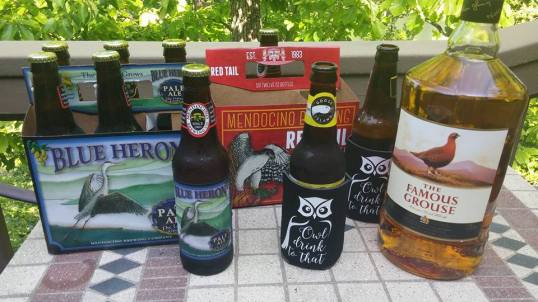
Michelle provided custom koozies for our bird-themed adult beverages to kick-off our Big Day adventures.
After a cocktail on the porch of my parents’ mountain home, we headed for an early pizza dinner before our 7:00 PM go-time, meeting up with our birding friend Theresa who lives in the area. Dinner ended right on time, and we headed out to the parking lot, averting our eyes from the European Starlings we’d seen on the power lines when we arrived and directing our attention to the Barn Swallows nesting among the eaves of the building. (While beautiful, starlings are unfortunately a non-native species that competes with native species for cavity nesting sites, and we preferred to have a native Georgia bird to kick off our count).
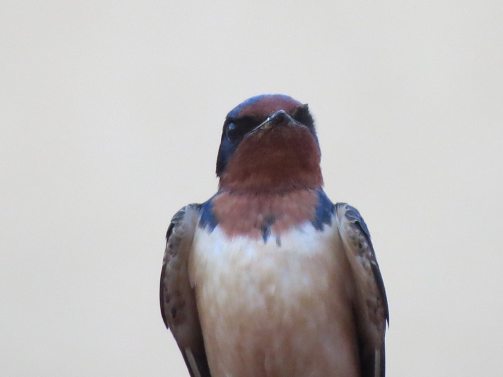
Barn Swallow at the Foothills IGA by Michelle Hamner
With the remaining daylight, we headed to a walking trail at some nearby meadows to see what we could find before nightfall, when we hoped to hear owls and other nocturnal birds. We picked up our first 20 species or so there, including an Eastern Screech Owl lazily peering at us from a nestbox in a tree along the trail.

Eastern Screech Owl by Theresa Hartz
At dusk, we headed to Theresa’s house, where we were delighted to hear an Eastern Whip-poor-will calling on cue, but we didn’t have any luck getting a Chuck-will’s-widow or a Barred Owl to answer the calls we played from the bird apps on our phones. As we were heading back to my parents’ house, I saw a clearing next to some dense woods and suggested we pull over and try our luck calling a Chuck-will’s-widow again. I rolled down my window and played the call on my phone, and instantly we had our reply—right outside the car window–as if I’d magically conjured the bird–a lifer for my teammates. (I couldn’t embed my sound recording, but have a listen here.)
Back at my parents’ house, the Barred Owls I often hear calling were quiet as we sat outside listening to the insects and frogs, and around 11 o’clock my teammates decided to turn in for the night since we planned to be up again at 5:30 AM. Being a night owl myself, I decided to sit outside on the porch awhile longer. Wouldn’t you know?! The house had just gotten dark and quiet when I heard the call of a Barred Owl! Since the rules of a Big Day require that all members of the group must see/hear 95% of the birds identified, I began quietly stomping on the deck and calling out, “Owl. Get out here!” toward my friends’ bedroom windows, purposefully opened for this reason.
Of course, once my friends were back outside in their pajamas, the bird was quiet. So we waited, probably only a few minutes, but feeling guilty for “crying owl,” I began to wonder if I’d conjured this bird only in my head. Finally, just as we were giving up, we all heard the familiar, “who cooks for you, who cooks for you all” of a Barred Owl in the distance.
The next morning we were out the door before 6:00 AM. Our plan was to visit some mountain locations before making our way down to Phinizy Swamp Nature Park in Augusta, where we hoped to see some shorebirds since we wouldn’t have time to go to the coast. At various mountain roadside stops, we found many of the expected local species as well as several species of migratory birds just returning to their breeding grounds after spending the winter in the tropics. Anyone who isn’t impressed with the variety of beautiful birds in North America hasn’t been paying enough attention! How can you not be wowed by birds like Chestnut-sided Warblers, Rose-breasted Grosbeaks, and Indigo Buntings?!
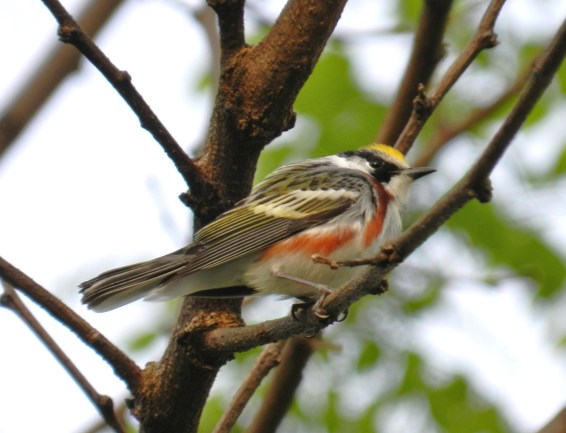
Chestnut-sided Warbler
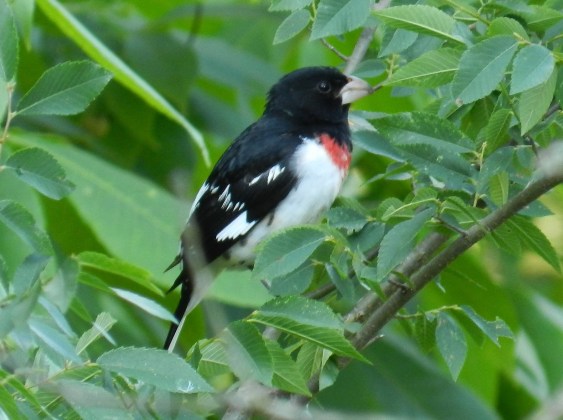
Rose-breasted Grosbeak
On our way to Augusta, we pulled over a few times in random places—adding Cooper’s Hawk and Purple Martins to our list, among others. My friend and coworker Dottie was extremely patient chauffeuring three people who were regularly pointing out the window and exclaiming, “what was that bird on that wire/house/fence?!” We almost missed our birding “hotspot” outside of Athens, an unmarked dirt road in the middle of nowhere that is popular with birders in the area. We had hoped to squeeze in a visit to the county dump (which is known to attract gulls, birds of prey, and other surprises) but were told that it wasn’t open to the public on that day of the week. After a quick bite to eat, we were on the road again headed to Augusta, right on schedule to arrive for a few hours of birding before our 7:00 PM cutoff. Just as we were approaching the swamp, we passed a promising spot beside a large lake called the “Mayor’s Fishing Pond.” After only a short time outside in the now steamy 90+ degree heat, our energy was starting to wane. Then Dottie spotted a pair of interesting looking birds circling overhead that Michelle and Mary identified as Mississippi Kites! We all forgot about being hot and tired and were practically dancing—an unexpected find and a life bird for my three teammates! We all felt reenergized and ready to continue our birding quest.
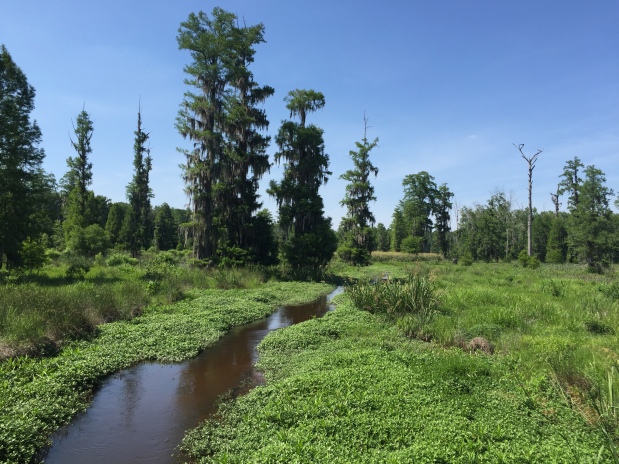
Phinizy Swamp Nature Park
Phinizy Swamp Nature Park is a lush and lovely place, and being the first time any of us had visited, we were excited to explore and see what we could find. As soon as we entered the parking lot, we were surrounded by birdsong. From the boardwalk trails, we saw egrets, ibis, and herons, as well as a colorful array of migratory songbirds like Blue Grosbeaks, Orchard Orioles, and Northern Parulas. At the end of the boardwalk trail, we were faced with a decision to make; trails leading into the wetlands stretched ahead in opposite directions, and we were still several birds shy of our goal of 100 species. Neither trail looked very inviting, stretching into the distance with no cover from the scorching sun. With the clock ticking down to our final two hours, we decided to take the trail that we thought would get us back to the parking lot sooner, hoping to pick up a few final species. We plodded along, scanning for birds who were wisely taking cover from the heat. An adorable family of grebes were the only birds we saw until we finally made it back to the tree line and collapsed in the shade, very close to calling it quits.
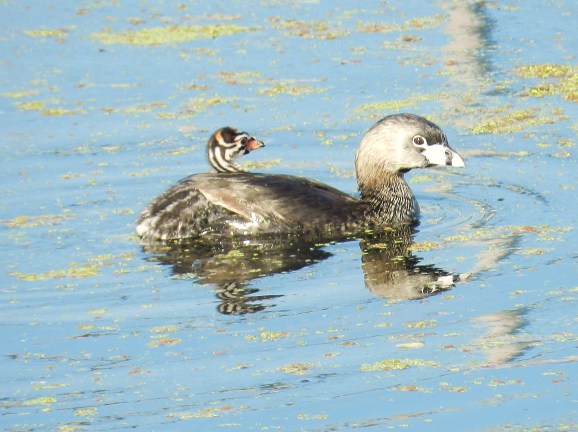
Pied-billed Grebe with one of her babies on her back.
Just then, Ruth, one of the park’s environmental educators that I had recently met at a conference, pulled up her SUV. She had heard that we would be visiting and had decided to try to find us to say hello before leaving work. What a savior! With just one hour left to go, we weren’t even sure we would make it back to our car by 7:00, much less find more birds. Ruth not only offered to give us a ride back to the parking lot, she offered to take the scenic route past much of the wetlands that we had missed! In that last hour, we picked up several additional species–Bobolinks, Painted Buntings, Glossy Ibis (a lifer for Dottie and Michelle), Spotted Sandpipers, and Wood Ducks. When Ruth dropped us off at the parking lot at about 7:01, our checklist was at 98 species. We were a little bummed we hadn’t met our goal, but we were all excited about the amazing birds we had seen.
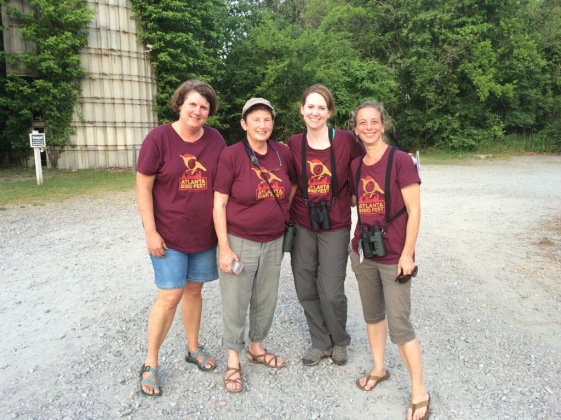
Tired and dirty, but still smiling at the end of our 24-hour birding bust…
As we sat and cooled off with a bird-themed beer, we reviewed our list again. Happily, we had miscounted! We had met our goal of 100 species after all. (Although truth be told, Ruth identified the distant flying Wood Ducks for us, so they wouldn’t count for an “official” Big Day, as outlined by the American Birding Association.) With a three hour drive to Atlanta ahead of us, we were ready for a good meal before getting back on the highway, but with less than four hours of sleep, I was struggling to keep my head off the table after a few bites.
The ride home was easy, and it was fun to reflect on all of the highlights of our 24-hour birding extravaganza—both the highs and the lows. I learned that a Big Day is a lot more about chasing birds than seeing birds. We spent several hours in the car (still birding!), and I’d guess that we identified at least half of our birds by ear only, rather than by sight. The pace is tiring, with little time to stop and “smell the roses.” (In fact, I got “fussed at” a couple of times for pausing to take photos of wildflowers.) Will I do it again next year? Absolutely! The colorful warblers, the nesting screech owl, the conjured Chuck-will’s-widow, the lifer Mississippi Kites, the family of grebes—all these amazing birds are right here in my very own state. Being outside with all senses tuned in to nature while exploring new places and having adventures with friends—all for a good cause–sign me up! Maybe you’d like to sign up next year, too?!
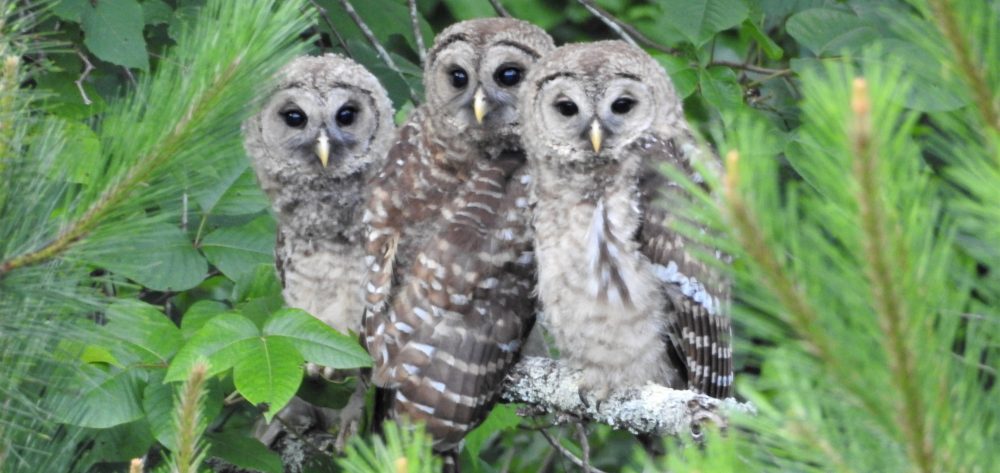
Owl drink to this post! Great yarn expertly spun and fun to read.
Thank you, Bill. I appreciate your kind words. Was glad to find some time to finally write again!
Love it. You are a great story teller. Linda
>
Thanks, Linda! Through Audubon and AWARE, I get a lot of great subject matter. 🙂